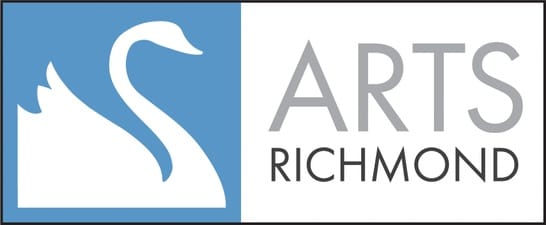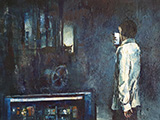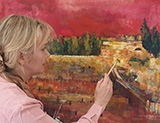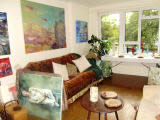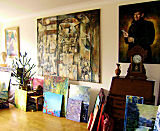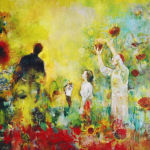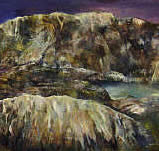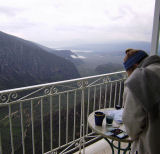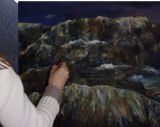Aesthetica
Dor Duncan's painting, Tournesol, has been commended in the Aesthetica Annual Competition 2010, organised by the UK arts and culture magazine, Aesthetica. Details appear in the Aesthetica Creative Works Annual 2011.
Ask a Question: Art and Oracle
An exhibition of paintings by Dor Duncan, inspired by Delphi, held at Riverside Gallery, Whittaker Avenue, Richmond, Surrey, TW9 1JP from 15th May to 10th July, 2010.
Gallery open: Monday, Thursday and Friday, 10am to 6pm; Tuesday and Saturday, 10am to 5pm; and Wednesday, 10am to 8pm.
Admission: Free
Phone: 020 8831 6000
galleryinfo@richmond.gov.uk
www.richmond.gov.uk/arts |
 |
Rocks, cliffs, gorges, the mountains around Delphi, site of the ancient oracle centre in Greece, this exhibition celebrates the Delphic experience, and invites visitors to come with a question and explore the links between art and oracle.
The paintings were prepared on site, on repeated visits over the past three winters. Painting in the mountains and caves, in all weathers and conditions, in the forbidding and beautiful setting of Mount Parnassos, Dor used local materials for these works in egg tempera, oil and watercolour.
The paints were made by hand, on location, with Greek egg yolks, essential oils from Greek Spike lavender and poppies, and Greek mineral and plant pigments.
“I wanted there to be a direct material link with Delphi, a Delphic experience even down to the physical composition of the paint,” says Dor.
Famed in the ancient world for the accuracy of its prophecies, as spoken by the sibyl, (an elderly priestess known as the ‘Pythia’), the Delphic sanctuary was dedicated both to Apollo and Dionysos. Apollo was God not only of prophecy, but also of truth, light, and the arts. In the winter months, Dionysos held sway over the mystery centre. He was God of epiphanies, pleasure, drama, cultivation of the vine, freedom from the self, and communication between the living and the dead. Not only prophecy therefore, but also the wider art of seeing – the search for truth and light – this was Delphi.
Dor Duncan’s Delphic experience takes shape in two rooms of Riverside Gallery in Richmond, Surrey. There are sheer and austere precipices, prophetic sunrises, bruised skies, in-coming storms, uncertain dusks, imaginative figure compositions, characters from everyday life, strangers and familiars, self portraits and characters from mythology – all become metaphors for inner dramas which await enlivenment through personal interpretation.
About three years ago there were widespread news reports after a research team suggested that the trances of the sibyl may have been caused by ethylene gases rising from below the earth. For Dor Duncan, this sheds less light on the Delphic experience than the aphorisms that were inscribed in the temple walls.
The three inscriptions were: ‘Know Thyself’; ‘Nothing in Excess/Everything in Moderation’; and ‘Make a pledge; mischief is nigh’.
“Delphi is a place perched on the edge of an abyss, seismic activity and rock falls are frequent,” says Dor. “Like art, danger breaks down boundaries between inner and outer, past, present and future, it unsettles you and readies you for revelations that the mind tells us are impossible”.
The exhibition is intended as part of a long tradition, where modern participants who visit the gallery continue to play a role in Delphi’s unfolding history, a history of revelation and the search for truth beyond time, self and place.
For over a thousand years, until the beginning of the first century, Delphi was consulted on all matters of political significance. The last documented answer was in 362 AD, when the Roman emperor Julian (named by the church “the Apostate”) sent messengers to consult Pythia, who pronounced her last oracle:
"Go and tell the king that the good times are gone, that Apollo does not have a shelter, nor laurel to pronounce his oracles and the water of the eloquent spring has gone dry."
The oracle was closed in 381 AD, when emperor Theodosius forbade Pagan cults. In time, the sanctuary fell to ruins. But if the spring had run dry, and prohibitions were in place, according to Dor Duncan, “an unbroken stream of “vision” continues to flow through cultures in the way of art. In this way, a Delphic tradition continues, Apollo is art and Dionysos frees us from ourselves”.
“The paintings are a pledge to Delphi,” says Dor, “they are open to whoever visits the gallery. My hope is that the visitors will be able to form a link between whatever questions they are considering and the Delphi that inspired these pictures.”
Back to Top
|
